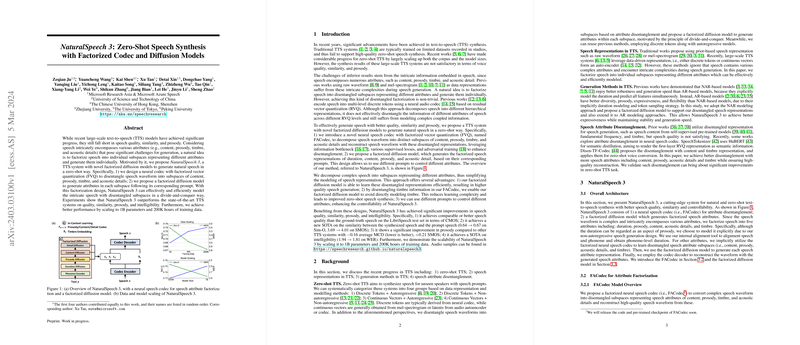Exploring Zero-Shot Speech Synthesis with \textit{NaturalSpeech 3}: A Leap Towards Natural and Controllable TTS Systems
Introduction
Text-to-speech (TTS) synthesis, the cornerstone of contemporary voice applications, has experienced remarkable advancements driven by the integration of deep learning. Despite these achievements, current large-scale TTS models still display limitations, particularly in achieving speech of superior quality, similarity, and prosody. To address these challenges, our paper introduces \textit{NaturalSpeech 3} (NS3), leveraging factorized diffusion models for zero-shot speech synthesis, drawing upon a novel neural codec equipped with factorized vector quantization (FVQ) for speech attribute disentanglement.
Key Contributions
\textit{NaturalSpeech 3} centers around two pivotal components: the FACodec for attribute factorization and the factorized diffusion model for efficient speech generation across disentangled subspaces.
- FACodec: This new codec disentangles speech into distinct subspaces, specifically content, prosody, timbre, and acoustic details, thereby simplifying the modeling process.
- Factorized Diffusion Model: Extended from FACodec's disentanglement, this diffusion model generates individual speech attributes in their respective subspaces, offering enhanced control and flexibility in speech synthesis.
Empirical Evaluation
Our comprehensive experiments demonstrate \textit{NaturalSpeech 3}'s superiority over existing TTS systems across multiple dimensions:
- Significantly improved speech quality, mirroring or surpassing ground-truth speech in both qualitative and quantitative measures on the LibriSpeech test set.
- Unprecedented accuracy in mimicking the prompt speech's voice and prosody, leading to state-of-the-art similarity scores.
- Enhanced speech intelligibility, as evidenced by a reduction in word error rate (WER) metrics.
Furthermore, the scalability of NS3 is showcased through experiments that expand the system to 1 billion parameters and 200k hours of training data, presenting a promising avenue for future enhancements.
Theoretical Implications and Future Directions
The introduction of NS3 constitutes a crucial step forward in the quest for highly natural and controllable speech synthesis. By conceptualizing speech as a conglomeration of disentangled attributes and applying a divide-and-conquer strategy in their generation, we inherently increase the model's control over the synthesized speech's characteristics. This flexibility paves the way for a myriad of applications, from customizable voice assistants to sophisticated audio content generation.
Future research directions could extend the efficacy of the factorized diffusion model and explore its applicability in multi-lingual contexts or other forms of audio synthesis. Additionally, investigating the semantic integration between textual content and prosodic features could yield further improvements in naturalness and expressiveness.
Conclusion
\textit{NaturalSpeech 3} propels the boundary of what's achievable in text-to-speech synthesis, marking a significant leap towards the realization of truly lifelike and customizable synthetic speech. Through its novel approach to speech factorization and generation, NS3 not only achieves state-of-the-art results but also introduces a versatile framework for future innovations in the field of generative AI.
